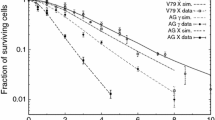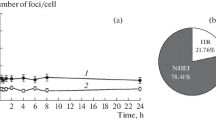Abstract
Mathematical analytical model of the processes running in individual radical clusters during the chemical phase (under the presence of radiomodifiers) proposed by us earlier has been further developed and improved. It has been applied to the data presented by Blok and Loman characterizing the oxygen effect in SSB and DSB formation (in water solution and at low-LET radiation) also in the region of very small oxygen concentrations, which cannot be studied with the help of experiments done with living cells. In this new analysis the values of all reaction rates and diffusion parameters known from literature have been made use of. The great increase of SSB and DSB at zero oxygen concentration may follow from the fact that at small oxygen concentrations the oxygen absorbs other radicals while at higher concentrations the formation of oxygen radicals prevails. It explains the double oxygen effect found already earlier by Ewing. The model may be easily extended to include also the effects of other radiomodifiers present in medium during irradiation.

Similar content being viewed by others
References
Mozumder A, Magee JL (1966) Model of tracsks of ionizing radiations of radical reaction mechanisms. Radiat Res 28:203–214
Mozumder A, Hatano Y (2004) Charged particle and photon interactions with matter. Marcel Dekker, New York
Deppman A et al (2004) Radiation interaction with DNA. Braz J Phys 34:958–61
Steel G (1993) Basic clinical radiobiology. Edward Arnold, London
Frankenberg-Schwager M et al (1980) The linear relationship between DNA double-strand breaks and radiation dose 30 MeV electrons is converted into a quadratic function by cellular repair. Int J Radiat Biol 37:207–12
Blok J, Loman H (1973) The effects of γ-radiation in DNA. Curr Top Radiat Res Q 9:165–245
Ewing D (1998) The oxygen fixation hypothesis. A revaluation. Am J Clin Oncol 21:355–361
Barilla J, Lokajíček M (2000) The role of oxygen in DNA damage by ionizing particles. J Theor Biol 207:405–414
Uehara S, Nikjoo H (2006) Monte Carlo simulation of water radiolysis for low-energy charged particles. J Radiat Res 47:69–81
Watanabe R, Saito K (2001) Monte Carlo simulation of water radiolysis in oxygenated condition for monoenergetic electrons from 100 eV to 1 MeV. Radiat Phys Chem 62(2–3):217–228
Beuve M, Colliaux A, Dabli D, Dauvergne D, Gervais B, Montarou G, Testa E (2009) Statistical effects of dose deposition in track-structure modelling of radiobiology efficiency. Nucl Instrum Methods Phys Res B 267(6):983–988
Solov’yov AV et al (2009) Physics of ion beam cancer therapy: a multiscale approach. Phys Rev E 79:011909
Lokajíček M (1986) Biophysical mechanism of cell inactivation by ionizing particles; report ICTP-399. International Centre for Theoretical Physics, Trieste
Hervé du Penhoat MA, Goulet T, Frongillo Y, Fraser MJ, Bernat P, Jay-Gerin JP (2000) Radiolysis of liquid water at temperatures up to 300°C: Monte Carlo simulation study. J Phys Chem 104:11757–11770
Chatterjee A, Maggie JL, Dex SK (1983) The role of homogeneous reaction in the radiolysis of water. Radiat Res 96:1–19
James F (1998) Function minimization and error analysis. CERN, Geneva
LaVerne JA, Pimblott SM (1991) Scavenger and time dependences of radicals and molecular products in the electron radiolysis of water. J Phys Chem 95:3196–3206
Michaels HB, Hunt JW (1978) A model for radiation damage in cells by direct effect and by indirect effect. Radiat Res 74:23–34
Author information
Authors and Affiliations
Corresponding author
Rights and permissions
About this article
Cite this article
Barilla, J., Lokajíček, M., Pisaková, H. et al. Analytical model of chemical phase and formation of DSB in chromosomes by ionizing radiation. Australas Phys Eng Sci Med 36, 11–17 (2013). https://doi.org/10.1007/s13246-012-0179-4
Received:
Accepted:
Published:
Issue Date:
DOI: https://doi.org/10.1007/s13246-012-0179-4




